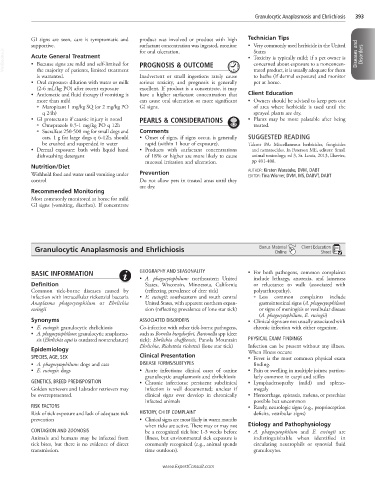Page 826 - Cote clinical veterinary advisor dogs and cats 4th
P. 826
Granulocytic Anaplasmosis and Ehrlichiosis 393
GI signs are seen, care is symptomatic and product was involved or product with high Technician Tips
supportive. surfactant concentration was ingested, monitor • Very commonly used herbicide in the United
VetBooks.ir Acute General Treatment PROGNOSIS & OUTCOME • Toxicity is typically mild; if a pet owner is Diseases and Disorders
States
for oral ulceration.
concerned about exposure to a nonconcen-
• Because signs are mild and self-limited for
the majority of patients, limited treatment
is warranted. Inadvertent or small ingestions rarely cause trated product, it is usually adequate for them
to bathe (if dermal exposure) and monitor
• Oral exposure: dilution with water or milk serious toxicity, and prognosis is generally pet at home.
(2-6 mL/kg PO) after recent exposure excellent. If product is a concentrate, it may
• Antiemetic and fluid therapy if vomiting is have a higher surfactant concentration that Client Education
more than mild can cause oral ulceration or more significant • Owners should be advised to keep pets out
○ Maropitant 1 mg/kg SQ (or 2 mg/kg PO GI signs. of area where herbicide is used until the
q 24h) sprayed plants are dry.
• GI protectants if caustic injury is noted PEARLS & CONSIDERATIONS • Plants may be more palatable after being
○ Omeprazole 0.5-1 mg/kg PO q 12h treated.
○ Sucralfate 250-500 mg for small dogs and Comments
cats, 1 g for large dogs q 6-12h, should • Onset of signs, if signs occur, is generally SUGGESTED READING
be crushed and suspended in water rapid (within 1 hour of exposure). Talcott PA: Miscellaneous herbicides, fungicides
• Dermal exposure: bath with liquid hand • Products with surfactant concentrations and nematocides. In Peterson ME, editors: Small
dishwashing detergent of 18% or higher are more likely to cause animal toxicology, ed 3, St. Louis, 2013, Elsevier,
mucosal irritation and ulceration. pp 401-408.
Nutrition/Diet
Withhold food and water until vomiting under Prevention AUTHOR: Kirsten Waratuke, DVM, DABT
EDITOR: Tina Wismer, DVM, MS, DABVT, DABT
control Do not allow pets in treated areas until they
are dry.
Recommended Monitoring
Most commonly monitored at home for mild
GI signs (vomiting, diarrhea). If concentrate
Granulocytic Anaplasmosis and Ehrlichiosis Bonus Material Client Education
Online
Sheet
BASIC INFORMATION GEOGRAPHY AND SEASONALITY • For both pathogens, common complaints
• A. phagocytophilum: northeastern United include lethargy, anorexia, and lameness
Definition States, Wisconsin, Minnesota, California or reluctance to walk (associated with
Common tick-borne diseases caused by (reflecting prevalence of deer tick) polyarthropathy).
infection with intracellular rickettsial bacteria • E. ewingii: southeastern and south central ○ Less common complaints include
Anaplasma phagocytophilum or Ehrlichia United States, with apparent northern expan- gastrointestinal signs (A. phagocytophilum)
ewingii sion (reflecting prevalence of lone star tick) or signs of meningitis or vestibular disease
(A. phagocytophilum, E. ewingii)
Synonyms ASSOCIATED DISORDERS • Clinical signs are not usually associated with
• E. ewingii: granulocytic ehrlichiosis Co-infection with other tick-borne pathogens, chronic infection with either organism.
• A. phagocytophilum: granulocytic anaplasmo- such as Borrelia burgdorferi, Bartonella spp (deer
sis (Ehrlichia equi is outdated nomenclature) tick); Ehrlichia chaffeensis, Panola Mountain PHYSICAL EXAM FINDINGS
Ehrlichia, Rickettsia rickettsii (lone star tick) Infection can be present without any illness.
Epidemiology When illness occurs:
SPECIES, AGE, SEX Clinical Presentation • Fever is the most common physical exam
• A. phagocytophilum: dogs and cats DISEASE FORMS/SUBTYPES finding.
• E. ewingii: dogs • Acute infections: clinical cases of canine • Pain or swelling in multiple joints; particu-
granulocytic anaplasmosis and ehrlichiosis larly common in carpi and stifles
GENETICS, BREED PREDISPOSITION • Chronic infections: persistent subclinical • Lymphadenopathy (mild) and spleno-
Golden retrievers and Labrador retrievers may infection is well documented; unclear if megaly
be overrepresented. clinical signs ever develop in chronically • Hemorrhage, epistaxis, melena, or petechiae
infected animals possible but uncommon
RISK FACTORS • Rarely, neurologic signs (e.g., proprioception
Risk of tick exposure and lack of adequate tick HISTORY, CHIEF COMPLAINT deficits, vestibular signs)
prevention • Clinical signs are most likely in warm months
when ticks are active. There may or may not Etiology and Pathophysiology
CONTAGION AND ZOONOSIS be a recognized tick bite 1-3 weeks before • A. phagocytophilum and E. ewingii are
Animals and humans may be infected from illness, but environmental tick exposure is indistinguishable when identified in
tick bites, but there is no evidence of direct commonly recognized (e.g., animal spends circulating neutrophils or synovial fluid
transmission. time outdoors). granulocytes.
www.ExpertConsult.com

